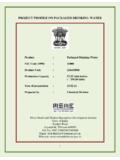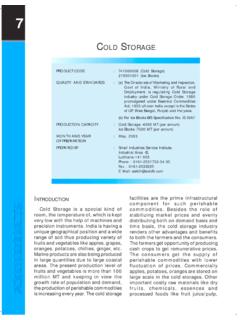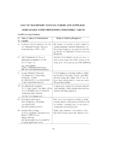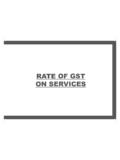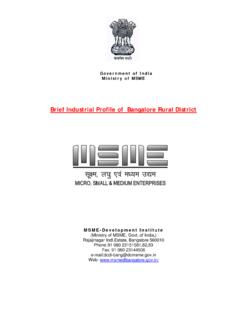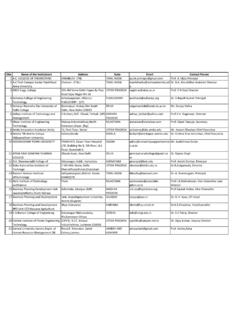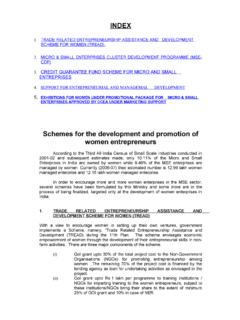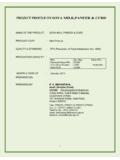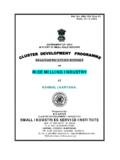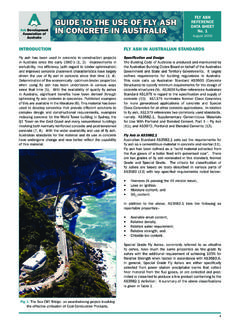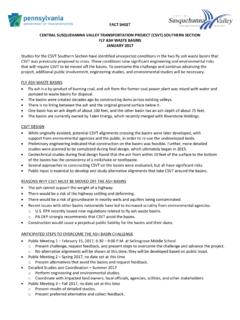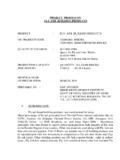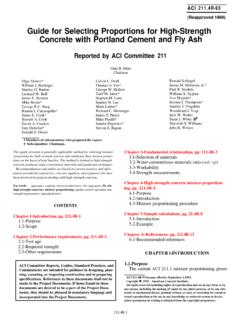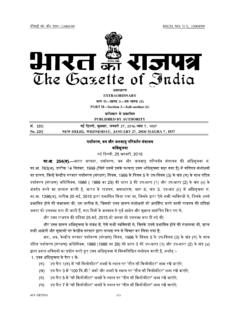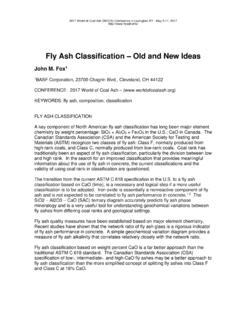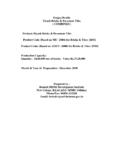Transcription of PROJECT PROFILE ON FLY ASH BRICKS - DCMSME
1 1 PROJECT PROFILE ON fly ash BRICKS 1. Product : fly ash BRICKS 2. Quality Standards : IS : 12894 :2002 3. Production Capacity quantity : 24 lakh BRICKS Value : Rs. 78 lakhs 4. Month & Year : March 2011 5. Prepared by : Asst. Director (G/C) MSME-DI, Guindy, Chennai. 2 1. INTRODUCTION : Pulverized fuel ash commonly known as fly ash is a useful by-product from thermal power stations using pulverized coal as fuel and has considerable pozzolonic activity. This national resource has been gainfully utilized for manufacture of pulverized fuel ash-lime BRICKS as a supplement to common burnt clay buildings BRICKS leading to conservation of natural resources and improvement in environment quality. Pulverized fuel ash-lime BRICKS are obtained from materials consisting of pulverized fuel ash in major quantity, lime and an accelerator acting as a catalyst.
2 Pulverized fuel ash-lime BRICKS are generally manufactured by intergrading blending various raw materials are then moulded into BRICKS and subjected to curing cycles at different temperatures and pressures. On occasion as and when required, crushed bottom fuel ash or sand is also used in the composition of the raw material. Crushed bottom fuel ash or sand is also used in the composition as a coarser material to control water absorption in the final product. Pulverized fuel ash reacts with lime in presence of moisture from a calcium hydrate which is a binder material. Thus pulverized fuel ash lime in presence of moisture form a calcium silicate hydrate which is binder material. Thus pulverized fuel ash lime brick is a chemically ended BRICKS .
3 These BRICKS are suitable for use in masonry construction just like common burnt clay BRICKS . Production of pulverized fuel ash-lime BRICKS has already started in the country and it is expected that this standard would encourage production and use on mass scale. This stand lays down the essential requirements of pulverized fuel ash BRICKS so as to achieve uniformity in the manufacture of such BRICKS . 3 The Proposed unit will be a started by one of the women entrepreneur and she have acquired EM Part I from the District Industries Centre, Kanchipuram, And also obtained all the statuary requirements to run the firm without any technical and managerial problems. 2. MARKET DEMAND: 180 billion tones of common burnt clay BRICKS are consumed annually approximately 340 billion tones of clay- about 5000 acres of top layer of soil dug out for BRICKS manufacture, soil erosion, emission from coal burning or fire woods which causes deforestation are the serious problems posed by brick industry.
4 The above problems can be reduced some extent by using fly ash BRICKS in dwelling units. Demand for dwelling units likely to raise to 80 million units by year 2015 for lower middle and low income groups, involving an estimated investment 0f $670 billion, according to the Associated chamber of commerce and industry. Demand for dwelling units will further grow to 90 million by 2020,which would requires a minimum investment of $890billion. The Indian housing sector at present faces a shortage of 20million dwelling units for its lower middle and low income groups which will witness a spurt of about dwelling units by the end of Tenth plan period. There is ample scope for fly ash brick and block units. In Chennai alone 1 crore BRICKS are required for constructional activities in every day.
5 But good quality of BRICKS as well as required quantity are not available moreover during the rainey seasons supply of clay BRICKS are very difficult. Therefore, in order to fulfill the required demand there will be a great chance to start more units in the field of fly ash BRICKS . 4 At present 20nos units are engaged and 40 lakhs nos of BRICKS per month are manufactured in our state. And there will be scope to start near about 100 units, which will be produced more than 2 cores no of BRICKS per month in future. Thus marketing of these product are well shinning. 3. BASIS AND PRESUMPTION OF THE PROJECT : i. The process of manufacture is on the basis of single shift of six hours per day with three hundred working days in a year.
6 Ii. To achieve full plant capacity it requires! year after trial production iii. Labor and wages mentioned in PROFILE are as per prevailing local rates. iv. Interest rate at considered in the PROJECT v. However the rate of interest may be varying while implementing PROJECT . vi. The Promoter contribution will be 5% of the total PROJECT cost which applicable in the PMEGP scheme. vii. The capacity of the unit 8000 BRICKS per day on the single sift basis. 5 MATERIALS fly ash s the inorganic mineral residue obtained after burning of coal/lignite in the boilers. fly ash is that portion of ash which is collected from the hoppers of ESP s and pond ash is collected from the ash ponds. Bottom ash is that portion of ash which can be collected fro the bottom portion of the boilers.
7 The characteristics of fly ash depend upon the quality of lignite/coal and the efficiency of boilers. India depends upon primarily on coal for the requirement of power and her power generation is likely to go up from 60,000MW in the year 2010. While generation of power from bituminous sources is on increase. The generation of fly ash is also likely to increase. The fly ash generation in India Thermal Stations is likely to shoot up to 170 million tones in 2010 from the present level of 100 million tones. The disposal of fly ash in the present method will be a big challenge to environment, especially when the quantum increases from the present level. The proposed unite will be using both type of fly ash depends upon the availbality Characteristics of fly ash The physical and chemical properties of fly ash are tabulated below i.
8 Physical Properties Specific Gravity to gm/cc Bulk Density gm/cc Fineness 350 to 450 M2/Kg ii. Chemical Properties 6 Silica 35-59 % Alumina 23-33% Calcium Oxide 10-16% Loss on ignition 1-2% Sulphur Iron % It may be seen that lignite fly ash is characterized primarily by the presence of silica, alumina, calcium etc. Presence of silica in fine form makes it excellent pozzolanic material. Its abundant availability at practically nil cost gives a very good opportunity for the construction agencies. Characteristics of Lignite and Coal fly ash : CONTENTS LIGNITE fly ash (%) COAL fly ash (%) TO 3-15 Sio2 40-64 A12 o3 23-33 15-29 Fe2 o3 2-11 CaO MgO So3 0-5. 0 About 50 to 80% fly ash may be used for the production. fly ash conform to IS 3812/1981is one of the important aspects.
9 GUPSUM: 7 Hydrated calcium sulphate are called gypsum. (Caso4 2H2O). Gypsum should have minimum 35% purity and 5 to 15% may be used. Lime : Quick Lime or hydrated lime or both can be mixed in the composition. Lime should have minimum 40% Cao content. Sand River sand should be clean & coarse. About 10 to 20% may used. All the raw materials are indigenous and readily available from the manufacture or traders 5. MANUFACTURING PROCESS: fly ash (70%)Lime (10%) Gypsum (5%) and sand(15%) are manually feed into a pan mixer where water is added to the required proportion for homogeneous mixing. The proportion of raw material may vary depending upon quality of raw materials. After mixing, the mixture are allowed to belt conveyor through feed in to automatic brick making machine were the BRICKS are pressed automatically.
10 Than the BRICKS are placed on wooden pallets and kept as it is for two days there after transported to open area where they are water cured for 10 -15 days. The BRICKS are sorted and tested before dispatch. 8 6. FLOW SHEET DIAGRAM fly ash Gypsum Lime Sand ---------------------------------------- ---------------------------------------- - Weighing Pan Mixer Conveyor fly ash Brick Making Machine (Hydralic (or) Power Press) Transported To Wooden Racks Kept as it is for two days for setting Water Curing (7 to 10 days) Drying (one or two days) Sorting and Testing Dispatch 9 7. INSPECTION AND QUALITY CONTROL : The Bureau of Indian Standards has formulated and published the specifications for maintaining quality of product and testing purpose.
